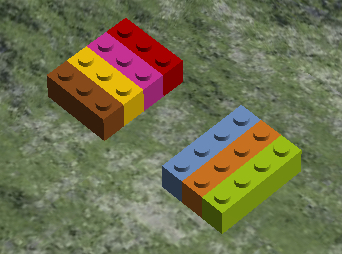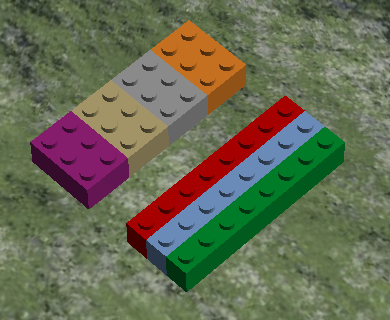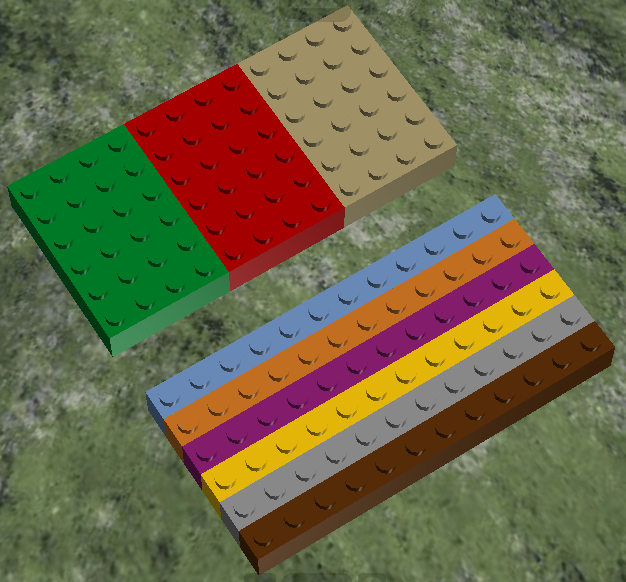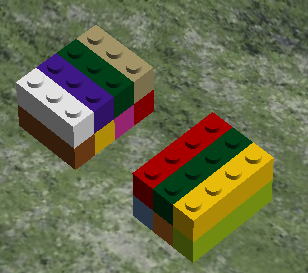Skip over navigation



Have a look at the three pictures above, each showing a pair of rectangles.
What do you see?
What mathematical relationships could these six arrangements show?
Begin to steer conversations towards mathematics, using relevant responses if possible. Ask children what mathematical relationships they can see represented by the Lego. Give time for them to talk in pairs again before taking some responses all together. Once you feel that everyone has grasped the task, give them time to work in pairs.
As you move around the room, listen in on conversations. Some pupils may focus initially on the colours and find relationships to link them. It may be necessary to talk with different pairs about what they are counting, whether it is rods (single width) or bricks (wider than 1) or the individual raised 'bumps' (you may find that the class agrees on a word to describe these).
If children record each number sentence on a separate strip of paper, you could create an engaging classroom display, with a photo of the Lego rectangles in the middle and examples of relationships around them. You could also jot down pupils' noticings and record them in speech bubbles along with the number sentences.
What have you noticed about these two rectangles that you are using?
How do you work out the relationship?
What calculations have you done?




Or search by topic
Number and algebra
Geometry and measure
Probability and statistics
Working mathematically
Advanced mathematics
For younger learners
Looking at Lego
Age 7 to 11
Challenge Level 





- Problem
- Getting Started
- Student Solutions
- Teachers' Resources
Looking at Lego



Have a look at the three pictures above, each showing a pair of rectangles.
What do you see?
What mathematical relationships could these six arrangements show?
Why do this problem?
The array structure of Lego offers a visual representation of multiplication and this activity encourages learners to make the connection between repeated addition and multiplication. The use of Lego as a stimulus for mathematical activity will provide a hook for some children and make them curious to explore further.Possible approach
Ideally, it would be good to create the rectangles yourself from Lego and display them on the table or floor with everyone sitting around. Ask children what they see and allow time for them to talk in pairs before coming together to share their thoughts. Try to welcome all contributions without placing value on some more than others. At this stage, pupils will comment on all sorts of things, not necessarily only the mathematical!Begin to steer conversations towards mathematics, using relevant responses if possible. Ask children what mathematical relationships they can see represented by the Lego. Give time for them to talk in pairs again before taking some responses all together. Once you feel that everyone has grasped the task, give them time to work in pairs.
As you move around the room, listen in on conversations. Some pupils may focus initially on the colours and find relationships to link them. It may be necessary to talk with different pairs about what they are counting, whether it is rods (single width) or bricks (wider than 1) or the individual raised 'bumps' (you may find that the class agrees on a word to describe these).
If children record each number sentence on a separate strip of paper, you could create an engaging classroom display, with a photo of the Lego rectangles in the middle and examples of relationships around them. You could also jot down pupils' noticings and record them in speech bubbles along with the number sentences.
Key questions
Tell me how you've done this.What have you noticed about these two rectangles that you are using?
How do you work out the relationship?
What calculations have you done?
Possible extension
Pupils may use manipulatives to create their own rectangles and show the relationships that are represented. Some learners may like to go further by considering cuboids instead of rectangles:
Possible support
Support may be given by using Lego or a similar manipulative so that multiplying can be modelled by making more rectangles the same and counting/adding where necessary.You may also like
Exploring Wild & Wonderful Number Patterns
EWWNP means Exploring Wild and Wonderful Number Patterns Created by Yourself! Investigate what happens if we create number patterns using some simple rules.
Sending Cards
This challenge asks you to investigate the total number of cards that would be sent if four children send one to all three others. How many would be sent if there were five children? Six?
Dice and Spinner Numbers
If you had any number of ordinary dice, what are the possible ways of making their totals 6? What would the product of the dice be each time?

